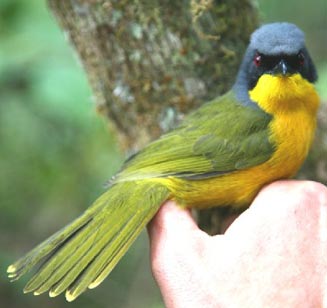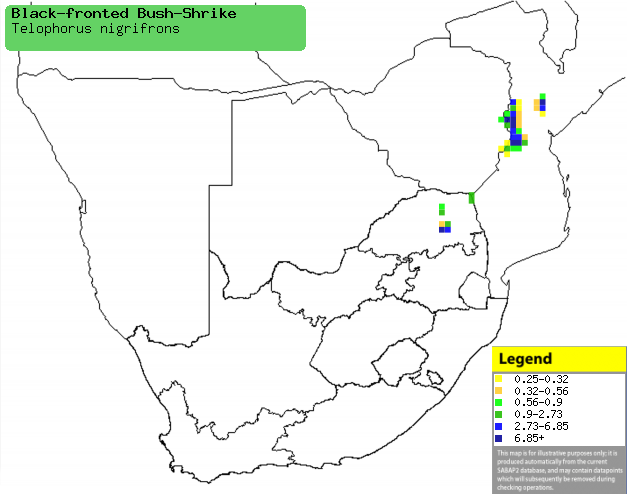|
Telophorus nigrifrons
(Black-fronted bush-shrike)
Swartoogboslaksman [Afrikaans]; Reichenow-bosklauwier
[Dutch]; Gladiateur à front noir [French]; Schwarzstirn-buschwürger [German];
Picanço-de-testa-preta [Portuguese]
Life
> Eukaryotes >
Opisthokonta
> Metazoa (animals) >
Bilateria >
Deuterostomia > Chordata >
Craniata > Vertebrata (vertebrates) > Gnathostomata (jawed
vertebrates) > Teleostomi (teleost fish) > Osteichthyes (bony fish) > Class:
Sarcopterygii (lobe-finned
fish) > Stegocephalia (terrestrial
vertebrates) > Tetrapoda
(four-legged vertebrates) > Reptiliomorpha > Amniota >
Reptilia (reptiles) >
Romeriida > Diapsida > Archosauromorpha > Archosauria >
Dinosauria
(dinosaurs) > Saurischia > Theropoda (bipedal predatory dinosaurs) >
Coelurosauria > Maniraptora > Aves
(birds) >
Order: Passeriformes
> Family: Malaconotidae
 |
|
|
Black-fronted bush-shrike, Udzungwa Mountains
National Park, Tanzania. [photo
Louis Andre Hansen ©] |
|
Distribution and habitat
Patchily distributed from Kenya and southern DRC through
Tanzania to southern Africa. Here it is fairly common but extremely difficult to
see, as it has much more shy and retiring then other bush-shrikes. It has small
populations in the eastern Zimbabwe forests bordering on Mozambique, as well as
in the north-eastern escarpment forests of the Limpopo Province and Mpumalalanga
(Graskop, Woodbush, Mariepskop) and the eastern Southpansberg (Hangklip and Entabeni forests).
|
 |
|
Distribution of Black-fronted bush-shrike in southern Africa,
based on statistical smoothing of the records from first SA Bird Atlas
Project (©
Animal Demography unit, University of
Cape Town; smoothing by Birgit Erni and Francesca Little). Colours range
from dark blue (most common) through to yellow (least common).
See here for the latest distribution
from the SABAP2. |
Food
It is insectivorous, working its way up the canopy of a
tree, gleaning insects from its leaves and branches until eventually it flies to
the base of another tree and repeats the process. It also joins mixed species
foraging flocks, especially in winter. The following food items have been
recorded in its diet:
Breeding
- Both sexes construct the nest, which is a scruffy, shallow saucer built of
fine twigs and dried creeper tendrils and lined with old mans beard (Usnea).
- Egg-laying season is from October-January.
- It lays 2 eggs, which are probably incubated by both sexes.
- Nothing much is known about the chicks development, other than that they
are fed by their parents after fledging.
Threats
Not threatened.s
References
-
Hockey PAR, Dean WRJ and Ryan PG 2005. Roberts
- Birds of southern Africa, VIIth ed. The Trustees of the John Voelcker
Bird Book Fund, Cape Town.
|
